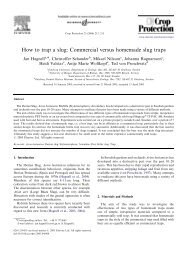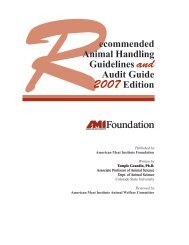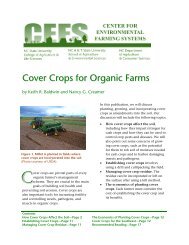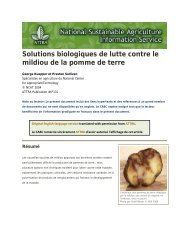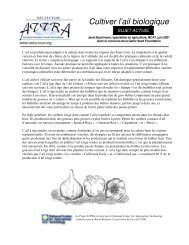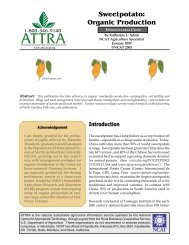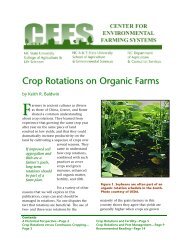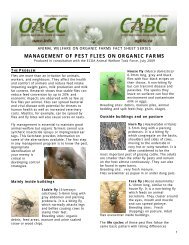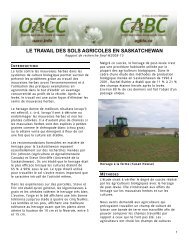Research Needs Assessment of Canadian Organic Farmers ...
Research Needs Assessment of Canadian Organic Farmers ...
Research Needs Assessment of Canadian Organic Farmers ...
You also want an ePaper? Increase the reach of your titles
YUMPU automatically turns print PDFs into web optimized ePapers that Google loves.
<strong>Organic</strong> <strong>Research</strong> <strong>Needs</strong> <strong>Assessment</strong>: Priorities by Production Sector – OACC 2009Appendix A: <strong>Organic</strong> <strong>Research</strong> Priorities Identified in Quebec.Source: CRAAQ, 2006. Priorities in <strong>Research</strong>, Technological Innovation and Technology Transfer<strong>Needs</strong> in <strong>Organic</strong> Farming. Presented by the <strong>Research</strong> Priorities Working Group, <strong>Organic</strong>agriculture committee, Centre de référence en agriculture et agroalimentaire du québec (CRAAQ)[Quebec Agriculture and Agri-food Reference Centre], May 2006.Key: Technological Innovation = ITechnology Transfer = T<strong>Research</strong> = RPriorities appearing in bold font have been identified as being <strong>of</strong> particular concern and should beaddressed through projects in the short term.Sectors Priorities TypeFruit and 1. Methods for fighting against the plum curculio in orchards. RSmall Fruit 2. Methods for fighting against the tarnished plant bug and the strawberry Rand raspberry weevil.3. Control <strong>of</strong> strawberry patch weeds in the 2 nd year <strong>of</strong> production: soil covering,mulch, weeding, etc.I4. Methods for fighting against gray mold (botrytis) and powdery mildew R(oidium) in strawberries.Field 5. Develop effective methods for fighting against pests that are difficult to R,I,TVegetables control in organic farming: tarnished plant bug, striped beetles affectingcucurbitaceae, cabbage maggots affecting cruciferae, carrot rust fly, fleabeetles, cauliflower cecidomyia.6. Evaluate the effectiveness <strong>of</strong> various low-risk products for use inR,Iphytoprotection, including hydrogen peroxide, sodium bicarbonate, vegetablepurines and compost extracts.7. Develop effective weed control methods that are adapted to organic farming. R,I,T8. Develop new fertilization strategies for organic vegetable farming. R,I,TGreenhouse 9. Develop criteria for using basic materials for the production <strong>of</strong> potting soil and I,TProduction <strong>of</strong> programs for fertilizing transplants that are adapted to different types <strong>of</strong> soil.10. Identify indicators <strong>of</strong> activity in the soil in order to increase the rates <strong>of</strong> Tmineralization, thereby making the soil’s CEC reserves available quickly.11. Define the optimum fertilization strategies for the creation and maintaining T<strong>of</strong> a sustainable system, i.e. that will not produce any surplus (losses into theenvironment) or nutritional imbalances.12. Define the optimum irrigation strategies for different types <strong>of</strong> soil in order tooptimize the diffusion <strong>of</strong> gases in the soil, soil activity, the efficiency <strong>of</strong> waterabsorption by the crop, and to avoid excessive losses into the environment.R,I,T13. Manage pathogens such as gray mold, stem canker and excess R,Ieelworms and pillbugs.Economics 14. Determine organic vegetable farming production costs. TandmanagementMaplesugaring15. Determine the effect <strong>of</strong> sodium hypochlorite when used as a resinchannel disinfectant, so it can be approved for use.16. Determine the effects <strong>of</strong> acetic acid in terms <strong>of</strong> residue left in the finishedproduct when it is utilized as a pot cleaner during the season.RR9



